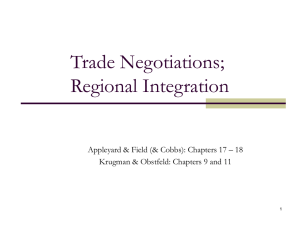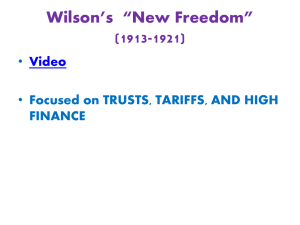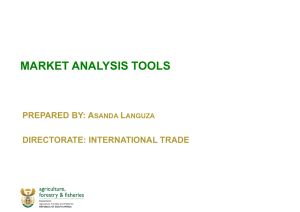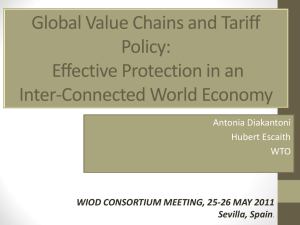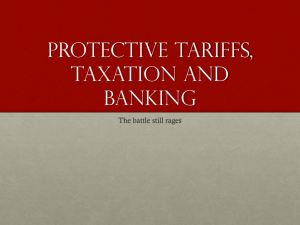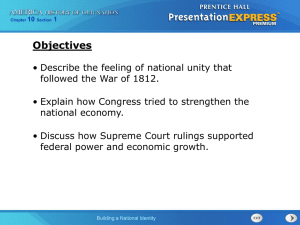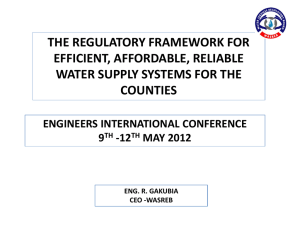Tariffication
advertisement
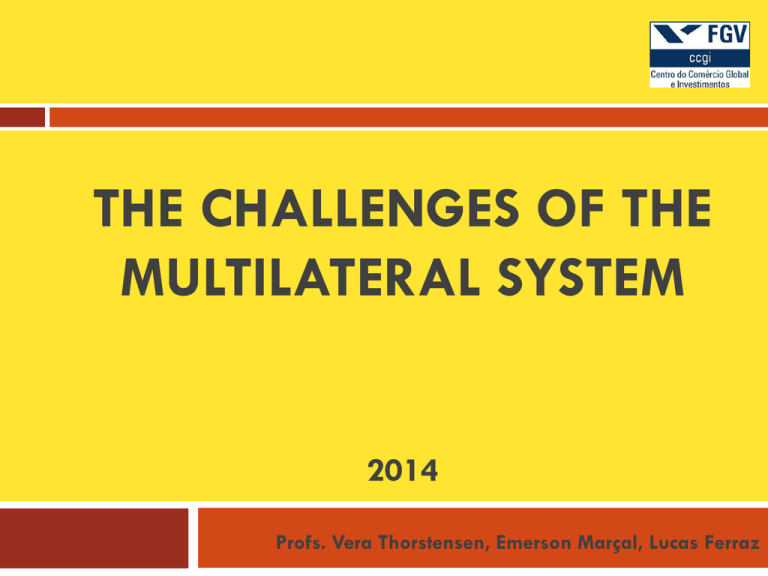
THE CHALLENGES OF THE MULTILATERAL SYSTEM 2014 Profs. Vera Thorstensen, Emerson Marçal, Lucas Ferraz Analysis of the Trading System 2 Multilateral Rules WTO (DSB), IMF, World Bank, OECD, UNCTAD, FAO, WIPO Preferential Rules Regional, Bilateral and Non reciprocal Agreements National Rules EU, USA, China, India, South Africa… Brazil Challenges 3 Multiplication of PTAs Logic of Global Value Chains Currency Wars 1 - PTAs 4 Types: RTAs, Bilateral, Non-reciprocal Scope: goods + services + IP + Inv + Comp + CC Issues: WTO in + WTO plus + WTO extra Mega-PTAs: US + EU China+Korea+Japan Number of PTAs 5 Source: WTO, 2012 MEGA 6 Agreements on rules not tariffs TBT + SPS Services + Int. Prop. (WTO +++) Investment + Competition + Environment (WTO extra) Regulatory coherence Disputes x DSB 65% of trade WTO ??? Impacts on WTO 7 - New WTO plus and WTO extra rules - WTO consistence - DSB x Mega PTAs dispute mecanism - Role of WTO ? Proposals: . Reinforce Committee on Regional Arrangements . Discuss Mega in each of WTO Committees . Bring new cases to DSB . Should outsiders propose a new agenda to WTO ? 2 - Transnationals and GVCs 8 Importance of trade among them (60%) Strong representation inside national governments Strong representation in the international arena Faceless organizations Fora for negotiations 9 Nationals Preferential agreements Plurilaterals States Universe X Transnationals Universe 10 States’ Logic Transnationals’ Logic • Trade in goods • Trade in tasks(value chains) • Tariffs, Quotas • No Tariffs, No Ad, No CVM, No Saf., No Pref. RO • AD, CVM, Safeguards • RO • Investment, competition, IP , Services • Subsidies • Harmonized standards (TBT/SPS) • DISPUTE SETTLEMENT • ARBITRATION Impacts of GVC on WTO / outsiders 11 - Old trade instruments: tariffs, AD, CVM, RO ? - New WTO trade instruments: comp, inv, env, clime? - Are Mega creating a dual WTO? - Will Mega create a fragmented DSB system ? - How far are outsiders involved in VAC? - Should oursiders have a new agenda in WTO ? 3 - Currency Wars 12 Number of countries with misalignments Persistance and magnitude of misalignments Where to judge exchange violations? Manipulators (IMF Art IV) x Frustrators (GATT Art XV) HOW TO ESTIMATE MISALIGNMENTS 13 PPP Equilibrium rate to current account balance (flow) Equilibrium rate to net foreign asstes (stocks) 14 Exchange rate – Big Mac 1/ 2014 IMF - Estimates Exchange Rate Misalignments (7/2014) Pilot External Sector Report 15 May-10 Oct-10 Apr-11 Oct-11 Apr-12 Oct-12 May-13 Oct-13 Venezuela United States United Kingdom Turkey Thailand Taiwan Switzerland Sweden South Africa Singapore Saudi Arabia Russia Poland Philippines Norway New Zealand Mexico Malaysia Korea Japan Israel Indonesia India Hungary 40% Hong Kong Euro Area Czech Republic Colombia China Chile Canada Brazil Australia Argentina PIIE - FEER – Misalignments – ClineWilliamson (10/2013) 16 Misalignment from FEER - Cline & Williamson 30% 20% 10% 0% -10% -20% -30% -40% FGV - China: real exchange rate, fundamentals and exchange rate misalignments (annually) 2013 17 Sources: Misalignment estimates – Observatory on Exchange Rate - EESP/FGV (2013) FGV - US: real exchange rate, fundamentals and exchange rate misalignments (annually) 2013 18 Source: Observatory on Exchange Rate - EESP/FGV (2013) FGV - Brazil: real exchange rate, fundamentals and exchange rate misalignments (annually) - 04/2014 19 175 Taxa de câmbio real Fundamentos 150 125 100 75 1980 1985 1990 1995 2000 2005 2010 1990 1995 2000 2005 2010 Desalinhamento cambial 0.25 0.00 -0.25 1980 1985 FGV - BRAZIL: Misalignments – different methods 20 FGV - Argentina: real exchange rate, fundamentals and exchange rate misalignments (annually) - 7/ 2013 21 FGV – Misalignments 2013 Source: Observatory on Exchange Rate 22 REER Misalignments - FGV 35% 30% 25% % to the equilibrium 20% 15% 10% 2011 5% 2012 2013 0% -5% -10% -15% “Tariffication” of exchange rate misalignments To exam the impact of exchange rate misalignments on trade, one possibility is to transform a misaligment into a tariff and then to adjust the import tariff of each country, through a “tariffication” exercise. An overvalued exchange rate has the effect of reducing or nullifying the import tariffs of the overvalued country, creating an incentive to imports from third countries. An undervalued exchange rate, on the other hand, will give an incentive to exports from the undervalued country. A country’s undervalued currency will have the effect of increasing its import tariffs, sometimes above the bound levels at the WTO. The equation used to “tarifficate” the effects of exchange rate misalignments is presented in the next slide Tariffication of Exchange Rates 24 Simulations regarding the effects of exchange rate misalignments on selected Tariff Profiles Using the “tariffication methodology”, one can represent the effects of exchange rate misalignments on a country Tariff Profile. The Tariff Profile is comprised of bound tariffs and applied tariffs Bound tariffs are the tariffs negotiated at the WTO as the maximum permitted level of an import tariff. Applied tariffs are the import tariffs actually applied by a country and notified to the WTO After applying the “tariffication methodology” the results are adjusted bound and applied tariffs that represent the actual level of protection of a given country. In the following slides we present the simulations for Brazil, US and EU Tariff Profiles, considering the effects of the exchange rate misalignments of selected countries. CHINA - Impacts of Exchange Rates on China Tariff Profile China devaluation 15% 2013 China Tariffs x Adjusted Tariffs - Effects of China Exchange Rate Devaluation Simple averages at HS 2 digits 60,00% Tobacco 50,00% Cereals Sugar Applied Tariffs (simple average) 40,00% Footwear Meat Furskins Wool Clothing Musical instruments Vehicles 30,00% Adjusted Applied Tariffs: China - 14% 20,00% Bound Tariffs (simple average) 10,00% 0,00% 1 - 4 - 7 - 10 - 13 - 16 - 19 - 22 - 25 - 28 - 31 - 34 - 37 - 40 - 43 - 46 - 49 - 52 - 55 - 58 - 61 - 64 - 67 - 70 - 73 - 76 - 79 - 82 - 85 - 88 - 91 - 94 - 97 - CHINA - Impacts of Exchange Rates on China Tariff Profile Ch-Brazil, Ch-Germany, Ch-US, Ch-Brazil in 2013 Bilateral Misalignments China Tariffs x Adjusted Tariffs - Effects of Selected Countries Exchange Rate Deviations Simple averages at HS 2 digits 120% Adjusted Applied Tariffs - effect of CH + BR deviations - 54% 100% 80% Adjusted Applied Tariffs - effect of CH + BR (06/12) deviations: 29% Brazilian exporter (2011) Adjusted Applied Tariffs - effect of GER + CH deviations: 12,5% 60% Brazilian exporter (06/12) Adjusted Applied Tariffs - effect of CH + USA deviations: 7% Bound Tariffs (simple average) 40% German exporter Applied Tariffs (simple average) 20% American exporter 0% 1 - 4 - 7 - 10 - 13 - 16 - 19 - 22 - 25 - 28 - 31 - 34 - 37 - 40 - 43 - 46 - 49 - 52 - 55 - 58 - 61 - 64 - 67 - 70 - 73 - 76 - 79 - 82 - 85 - 88 - 91 - 94 - 97 - US - Impacts of Exchange Rates on US Tariff Profile US devaluation in 2013 ( - 5%) US Applied Tariffs x Adjusted Tariffs - Effects of US Exchange Rate Devaluation Simple averages at HS 2 digits 30% 180% Tobacco 25% 160% 158% 146% 141% 140% Clothing 20% 120% Dairy Footwear vegetables 15% 100% Leather Applied tariffs Locomotive 10% 80% 60% 40% 5% 20% 0% Adjusted applied tariffs: USA - 7% Bound tariffs 0% 1 - 4 - 7 - 10 - 13 - 16 - 19 - 22 - 25 - 28 - 31 - 34 - 37 - 40 - 43 - 46 - 49 - 52 - 55 - 58 - 61 - 64 - 67 - 70 - 73 - 76 - 79 - 82 - 85 - 88 - 91 - 94 - 97 - Impacts of Exchange Rates on US Tariff Profile US-Brazil US-Spain US-China and US-Brazil in Bilateral Misalignments (2013) USA Applied Tariffs x Adjusted Tariffs - Effects of Selected Countries Deviations (Article I) Simple averages at HS 2 digits 70% Brazilian exporter(2011) 60% Adjusted applied tariffs - effect of USA + BR: 47% 50% Adjusted applied tariffs - effect of USA + BR: 22% (06/2012) 40% Brazilian exporter (06/2012) Adjusted applied tariffs - effect of USA + SPAIN: 13,8% 30% 20% 10% Bound tariffs Spanish exporter Applied tariffs 0% -10% Chinese exporter -20% 1 - 4 - 7 - 10 - 13 - 16 - 19 - 22 - 25 - 28 - 31 - 34 - 37 - 40 - 43 - 46 - 49 - 52 - 55 - 58 - 61 - 64 - 67 - 70 - 73 - 76 - 79 - 82 - 85 - 88 - 91 - 94 - 97 - Adjusted applied tariffs - effect of USA + CH: 7% Impacts of Exchange Rates on EU Tariff Profile Brazil US China 2013 30 EU Market - Effects of Selected Countries Deviations (Article I) Simple averages at HS 2 digits - Exchange rate misalignments for 2011-12 120% Adjusted Applied Tariffs Exchange Rate Overvaluation BR - 40% 100% Adjusted Applied Tariffs Exchange Rate Overvaluation BR - 15% (06/2012) 80% Brazilian exporter (2011) Bound Tariffs 60% Applied Tariffs 40% Brazilian exporter (06/2012) Adjusted Applied Tariffs Exchange Rate Devaluation USA - 7% 20% American exporter Adjusted Applied Tariffs Exchange Rate Devaluation China - 14% 0% -20% Chinese exporter 1 - 4 - 7 - 10 - 13 - 16 - 19 - 22 - 25 - 28 - 31 - 34 - 37 - 40 - 43 - 46 - 49 - 52 - 55 - 58 - 61 - 64 - 67 - 70 - 73 - 76 - 79 - 82 - 85 - 88 - 91 - 94 - 97 - Brazil - Impacts of misalignments on Tariffs 2012 (+20%) 2013 (+15%) 31 Brazil Tariffs x Adjusted Tariffs - Effects of Brazil Exchange Rate Overvaluation (2012) Simple averages at HS 2 digits 60% 50% Clothing 40% Bound Tariffs (simple averages) 30% Leather 20% Sugar Vehicles Cotton Beverages Tools Dairy Steel Applied Tariffs Tobacco 10% Adjusted Bound Tariffs Exchange Rate Overvaluation BR + 20% 0% 1 - 4 - 7 - 10 - 13 - 16 - 19 - 22 - 25 - 28 - 31 - 34 - 37 - 40 - 43 - 46 - 49 - 52 - 55 - 58 - 61 - 64 - 67 - 70 - 73 - 76 - 79 - 82 - 85 - 88 - 91 - 94 - 97 -10% -20% -30% Adjusted Applied Tariffs Exchange Rate Overvaluation BR + 20% Impacts of Exchange Rates on Brazil Tariff Profile Brazil-China Brazil-US Brazil-Germany Bilateral Misalignments in 2013 32 Brazilian Market Adjusted for Multiple Exchange Rate Misalignments Simple averages at HS 2 digits 40% Clothing 30% Tobacco 20% Dairy Beverages Leather Vehicles Cotton Tools Steel Sugar Applied Tariffs 10% Brazilian Producer 0% -10% Adjusted Applied Tariffs effect of BR + GER: 24% -20% Adjusted Applied Tariffs effect of BR + USA: 25% -30% Adjusted Applied Tariffs effect of BR + CH: 37% -40% -50% 1 - 4 - 7 - 10 - 13 - 16 - 19 - 22 - 25 - 28 - 31 - 34 - 37 - 40 - 43 - 46 - 49 - 52 - 55 - 58 - 61 - 64 - 67 - 70 - 73 - 76 - 79 - 82 - 85 - 88 - 91 - 94 - 97 - Conclusions 33 - Countries with overvalued exchange rates (Brazil, South Africa, Australia) have their negotiated tariffs reduced or nullified. - Countries with undervalued exchange rates (USA, China, Germany) grant subsidies to their exports and their applied tariffs surpass the bound levels agreed at the WTO. - Substantial and persistent exchange rate misalignments significantly affect or nullify most WTO rules: tariffs, antidumping, countervailing measures, safeguards, rules of origin, regional agreements, DSB retaliations… - Problem: WTO does not have adequate rules to address the exchange rate issue HOW TO SOLVE THE PROBLEM IMF - manipulation (Article IV) WTO - frustration (Article XV) WTO Rules relating trade and exchange rates General Agreement on Tariffs and Trade (GATT) Article XV.4 Contracting parties shall not, by exchange action, frustrate* the intent of the provisions of this Agreement, nor, by trade action, the intent of the provisions of the Articles of Agreement of the International Monetary Fund. * Ad Article XV -Paragraph 4 The word “frustrate” is intended to indicate, for example, that infringements of the letter of any Article of this Agreement by exchange action shall not be regarded as a violation of that Article if, in practice, there is no appreciable departure from the intent of the Article. Thus, a contracting party which, as part of its exchange control operated in accordance with the Articles of Agreement of the International Monetary Fund, requires payment to be received for its exports in its own currency or in the currency of one or more members of the International Monetary Fund will not thereby be deemed to contravene Article XI or Article XIII. Another example would be that of a contracting party which specifies on an import license the country from which the goods may be imported, for the purpose not of introducing any additional element of discrimination in its import licensing system but of enforcing permissible exchange controls. A NEW PROPOSAL 36 - Create a world currency - Negotiate a fluctuation band - Solve the conflict bilaterally BOX OF SNAKES Misalignments band 23 countries (03/14) 37 4 Normalized World Trade Currency PPP 3 2 1 0 -1 -2 -3 United States Brazil Australia Austria Belgium Canada China France Germany India Italy Japan South Korea Mexico Netherlands Spain Sweden Switzerland United Kingdom Malaysia Noruega Portugal Finlândia +- 2 S.D. +- 1 S.D. Mar-14 May-13 Jul-12 Sep-11 Nov-10 Jan-10 Mar-09 May-08 Jul-07 Sep-06 Nov-05 Jan-05 Mar-04 May-03 Jul-02 Sep-01 Nov-00 Jan-00 Mar-99 May-98 Jul-97 Sep-96 Nov-95 Jan-95 Mar-94 May-93 Jul-92 Sep-91 Nov-90 Jan-90 Mar-89 May-88 Jul-87 Sep-86 Nov-85 Jan-85 Mar-84 May-83 Jul-82 Sep-81 Nov-80 Jan-80 -4 -4 United States Austria Belgium France Germany Italy Netherlands Spain Sweden Switzerland United Kingdom Portugal Finlândia +- 2 S.D. +- 1 S.D. Mar-14 May-13 Jul-12 Sep-11 Nov-10 Jan-10 Mar-09 May-08 Jul-07 Sep-06 Nov-05 Jan-05 Mar-04 May-03 Jul-02 Sep-01 Nov-00 Jan-00 Mar-99 May-98 Jul-97 Sep-96 Nov-95 Jan-95 Mar-94 May-93 Jul-92 Sep-91 Nov-90 Jan-90 Mar-89 May-88 Jul-87 Sep-86 Nov-85 Jan-85 4 Mar-84 May-83 Jul-82 Sep-81 Nov-80 Jan-80 BOX OF SNAKES FOR TTIP (03-2014) 38 Normalized World Trade Currency PPP - Selected TTIP Countries 3 2 1 0 -1 -2 -3 Jan-80 -4 United States Australia Canada Japan Singapore Chile Mexico Malaysia +- 2 S.D. +- 1 S.D. Mar-14 May-13 Jul-12 Sep-11 Nov-10 Jan-10 Mar-09 May-08 Jul-07 Sep-06 Nov-05 Jan-05 Mar-04 May-03 Jul-02 Sep-01 Nov-00 Jan-00 Mar-99 May-98 Jul-97 Sep-96 Nov-95 Jan-95 Mar-94 May-93 Jul-92 Sep-91 Nov-90 Jan-90 Mar-89 May-88 Jul-87 Sep-86 Nov-85 Jan-85 Mar-84 May-83 Jul-82 Sep-81 Nov-80 BOX OF SNAKES FOR TPP (03/2014) 39 Normalized World Trade Currency PPP - TPP Countries 4 3 2 1 0 -1 -2 -3 BOX OF SNAKES FOR EU AND BRAZIL (03/2014) 40 4 Normalized World Trade Currency PPP - Selected TTIP Countries + Brazil 3 2 1 0 -1 -2 United States Germany Sweden Finlândia Austria Italy Switzerland Brazil Belgium Netherlands United Kingdom +- 2 S.D. France Spain Portugal +- 1 S.D. Mar-14 May-13 Jul-12 Sep-11 Nov-10 Jan-10 Mar-09 May-08 Jul-07 Sep-06 Nov-05 Jan-05 Mar-04 May-03 Jul-02 Sep-01 Nov-00 Jan-00 Mar-99 May-98 Jul-97 Sep-96 Nov-95 Jan-95 Mar-94 May-93 Jul-92 Sep-91 Nov-90 Jan-90 Mar-89 May-88 Jul-87 Sep-86 Nov-85 Jan-85 Mar-84 May-83 Jul-82 Sep-81 Nov-80 -4 Jan-80 -3 How to neutralize ? 41 In the WTO - Tariffs - Anti- subsidies - Currency safeguards - Compensation In the PTAs - Reduction of preference

